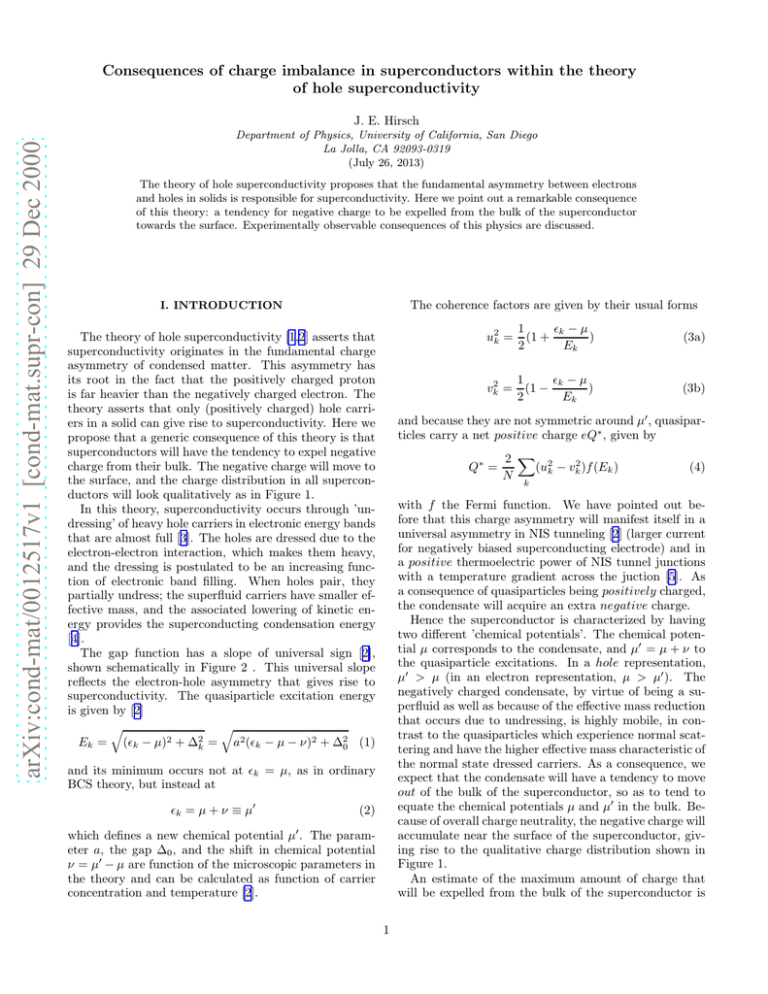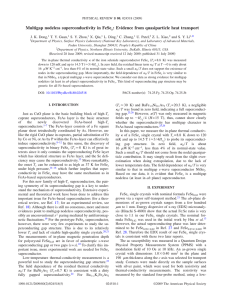Consequences of charge imbalance in superconductors within the
advertisement

Consequences of charge imbalance in superconductors within the theory of hole superconductivity arXiv:cond-mat/0012517v1 [cond-mat.supr-con] 29 Dec 2000 J. E. Hirsch Department of Physics, University of California, San Diego La Jolla, CA 92093-0319 (July 26, 2013) The theory of hole superconductivity proposes that the fundamental asymmetry between electrons and holes in solids is responsible for superconductivity. Here we point out a remarkable consequence of this theory: a tendency for negative charge to be expelled from the bulk of the superconductor towards the surface. Experimentally observable consequences of this physics are discussed. The coherence factors are given by their usual forms I. INTRODUCTION The theory of hole superconductivity [1,2] asserts that superconductivity originates in the fundamental charge asymmetry of condensed matter. This asymmetry has its root in the fact that the positively charged proton is far heavier than the negatively charged electron. The theory asserts that only (positively charged) hole carriers in a solid can give rise to superconductivity. Here we propose that a generic consequence of this theory is that superconductors will have the tendency to expel negative charge from their bulk. The negative charge will move to the surface, and the charge distribution in all superconductors will look qualitatively as in Figure 1. In this theory, superconductivity occurs through ’undressing’ of heavy hole carriers in electronic energy bands that are almost full [3]. The holes are dressed due to the electron-electron interaction, which makes them heavy, and the dressing is postulated to be an increasing function of electronic band filling. When holes pair, they partially undress; the superfluid carriers have smaller effective mass, and the associated lowering of kinetic energy provides the superconducting condensation energy [4]. The gap function has a slope of universal sign [2], shown schematically in Figure 2 . This universal slope reflects the electron-hole asymmetry that gives rise to superconductivity. The quasiparticle excitation energy is given by [2] q q Ek = (ǫk − µ)2 + ∆2k = a2 (ǫk − µ − ν)2 + ∆20 (1) ǫk − µ 1 ) (1 + 2 Ek (3a) vk2 = 1 ǫk − µ ) (1 − 2 Ek (3b) and because they are not symmetric around µ′ , quasiparticles carry a net positive charge eQ∗ , given by Q∗ = 2 X 2 (uk − vk2 )f (Ek ) N (4) k with f the Fermi function. We have pointed out before that this charge asymmetry will manifest itself in a universal asymmetry in NIS tunneling [2] (larger current for negatively biased superconducting electrode) and in a positive thermoelectric power of NIS tunnel junctions with a temperature gradient across the juction [5]. As a consequence of quasiparticles being positively charged, the condensate will acquire an extra negative charge. Hence the superconductor is characterized by having two different ’chemical potentials’. The chemical potential µ corresponds to the condensate, and µ′ = µ + ν to the quasiparticle excitations. In a hole representation, µ′ > µ (in an electron representation, µ > µ′ ). The negatively charged condensate, by virtue of being a superfluid as well as because of the effective mass reduction that occurs due to undressing, is highly mobile, in contrast to the quasiparticles which experience normal scattering and have the higher effective mass characteristic of the normal state dressed carriers. As a consequence, we expect that the condensate will have a tendency to move out of the bulk of the superconductor, so as to tend to equate the chemical potentials µ and µ′ in the bulk. Because of overall charge neutrality, the negative charge will accumulate near the surface of the superconductor, giving rise to the qualitative charge distribution shown in Figure 1. An estimate of the maximum amount of charge that will be expelled from the bulk of the superconductor is and its minimum occurs not at ǫk = µ, as in ordinary BCS theory, but instead at ǫk = µ + ν ≡ µ′ u2k = (2) which defines a new chemical potential µ′ . The parameter a, the gap ∆0 , and the shift in chemical potential ν = µ′ − µ are function of the microscopic parameters in the theory and can be calculated as function of carrier concentration and temperature [2]. 1 and plug holes, thus underdoping those regions. The direct observation that grain boundaries are underdoped in Y BCO [8] was made at liquid nitrogen temperatures [10], hence in the superconducting state. Our scenario predicts that the effect should disappear at temperatures above Tc . (4) If there is negative surface charge in superconductors one would expect that it will be relatively easy to remove when it is rubbed against a non-superconductor which is poorly or non-conducting (otherwise the charge would be transfered back upon separation). Hence superconductors should be at the top of the triboelectric series [11]. To our knowledge, triboelectric properties of superconductors have never been examined. To obtain quantitative answers for the charge distribution in a superconductor of given shape, or in the mixed state, it is necessary to solve the Bogoliubov - de Gennes equations, which will be the subject of future work. We expect that quite generally a higher density of negatively charged superfluid near the surfaces will result. Note also that in a superconducting body the electric current is carried only by the superconducting electrons in a surface layer, of thickness given by the penetration depth. It is natural to expect that the higher density of superfluid should occur in the region where it is useful to conduct electricity. In conclusion, we point out that the inhomogeneous charge distribution of figure 1 mirrors the one at the atomic level: in an atom, the heavy positive charge is concentrated in the nucleus and the light negative charge extends out. Within the theory of hole superconductivity, superconductors are solids where many antibonding electronic states are occupied. To relieve the associated energy cost these electrons, which have high kinetic energy and effective mass, condense into the superconducting state, thus lowering their kinetic energy and effective mass. The resulting light superfluid moves out towards the surface, just as light electrons in atoms do not remain confined within the dimensions of the positive nucleus. Thus we propose that superconducting solids can in some sense be regarded as ’giant atoms’. Futher consequences of this physics will be discussed in future work. given by the ratio of the difference in chemical potentials to the bandwidth D nmax = 2ν 2(µ′ − µ) = D D (5) carriers per site. For typical parameters in the model ν ∼ 1meV , D ∼ 0.5eV , yielding nmax ∼ 0.004 electrons per atom. However the tendency to charge expulsion will be counteracted by Coulomb charging energy. The net effect will be most pronounced in superconducting bodies of small volume, i.e. large surface to volume ratio. We next discuss some expected experimental consequences of this effect: (1) Consider a superconductor in the mixed state. Depending on the value of the applied magnetic field, the surface to volume ratio of the superconducting regions can be made very large. We expect that negative charge will be expelled from the superconducting regions into the normal vortex cores. Recently it has been reported [6] that indeed in Y Ba2 Cu3 O7 in the mixed state, the vortices are negatively charged relative to the superconducting regions. However, reference 6 also reports that in Y Ba2 Cu4 O8 the vortices are positively charged, and concludes that generally vortices will be negatively charged in the overdoped regime and positively charged in the underdoped regime. We believe that this conclusion is erroneous: our theory predicts universally negatively charged vortices. The conclusion of Ref. 6 for Y Ba2 Cu4 O8 could be due either to an experimental artifact or to other non-intrinsic physical processes occuring in that material. (2) Consider the recent remarkable experiment reported by Tao and coworkers [7]: granular superconducting particles in an electric field aggregate to form round balls of macroscopic dimensions. We propose the following qualitative explanation : in the absence of electric field, the granular particles with charge distribution as in Figure 1 produce no electric field outside, hence there is no electrostatic force between granules. When the electric field is turned on the granules polarize and the resulting electric dipoles attract, so that granules will join and allign parallel to the field direction. However when granules join the negative charge on the parts of the surfaces that join will move to the outer surface. The resulting negative charge distribution on the surface will exert a force to distort the elongated shape onto a spherical shape which gives rise to minimum surface energy of the negative charge. The result is the spherical ball of macroscopic dimensions seen experimentally [7]. (3) In polycrystalline samples of high Tc materials it is observed that a depletion of hole carriers occurs close to grain boundaries [8]. In fact it was recently proposed that overdoping of grain boundaries is an effective way to increase critical current densities in high Tc materials [9]. We propose that this depletion of hole carriers occurs because negative charge expelled from the bulk of the superconductor will migrate to the grain boundaries [1] J. E. Hirsch, Phys.Lett. A134, 451 (1989); Physica C 158, 326 (1989); Phys.Lett. A138, 83 (1989); Phys. Rev. B 48, 3327 (1993). [2] J.E. Hirsch and F. Marsiglio, Phys. Rev. B 39, 11515 (1989); Physica C 162-164, 591 (1989); F. Marsiglio and J.E. Hirsch, Phys. Rev. B 41, 6435 (1990); Phys. Rev. B 44, 11960 (1991). [3] J. E. Hirsch, Phys. Rev. B 62, 14487 (2000). [4] J.E. Hirsch and F. Marsiglio, Phys. Rev. B 45, 4807 (1992); Phys. Rev. B 62, 15131 (2000); Physica C 331, 2 150 (2000); J. E. Hirsch, Physica C 199, 305 (1992). [5] J.E. Hirsch, Phys. Rev. Lett. 72, 558 (1994); Phys. Rev. B 58, 8727 (1998). [6] K. Kumagai, K. Nozaki and Y. Matsuda, condmat/0012492. [7] R. Tao, X. Zhang, X. Tang and P.W. Anderson, Phys. Rev. Lett. 83, 5575 (1999). [8] S.E. Babcock et al, Physica C 227, 183 (1994). [9] A. Schmehl et al, Europhys.Lett. 47, 110 (1999). [10] S.E. Babcock, private comm. [11] D.J. Montgomery, Solid State Physics Vol. 9, p. 139 (1959). FIG. 1. Schematic picture of a spherical superconducting body. Negative charge is expelled from the bulk to the surface. FIG. 2. Schematic picture of the energy gap function ∆k and quasiparticle energy Ek versus hole kinetic energy ǫk in the model of hole superconductivity. The minimum in the quasiparticle energy is shifted from the chemical potential µ to µ + ν. 3 Figure 1



